Site Menu:
| This is an archived Horseadvice.com Discussion. The parent article and menus are available on the navigation menu below: |
| HorseAdvice.com » Diseases of Horses » Skin Diseases, Wounds, and Swellings » Wounds / Burns » Wounds: First Aid Care » |
| Discussion on Rope burn/cut on hock (part 2) | |
| Author | Message |
| Member: hwood |
Posted on Monday, Sep 24, 2007 - 1:27 am: I know it's taking a long time to download the Rope burn/cut on hock discussion, so made a part 2.Dr. O, I had to wait for rewrapping time today before I could handle that swelling on the inside of the hock. It seems to be firmly mushy, so I'm hopeful that it is edema and will eventually subside. The skin around the larger, horizontal injury seems to collect water at hosing time, too, so today, as I dried Dixie's leg, I used upward pressure with the towel to get any extra liquid out of the "pocket" before I rebandaged her. I saw a 1/4" piece of skin let loose and wash away during the hosing today. Finished Tucoprim last night. Am still giving 1 gram of Bute 2x a day, but am not sure that it is necessary. As long as there is swelling, I figure it might not hurt. Vet is due on Wednesday. Here are before hosing and after hosing pics of Day 6.  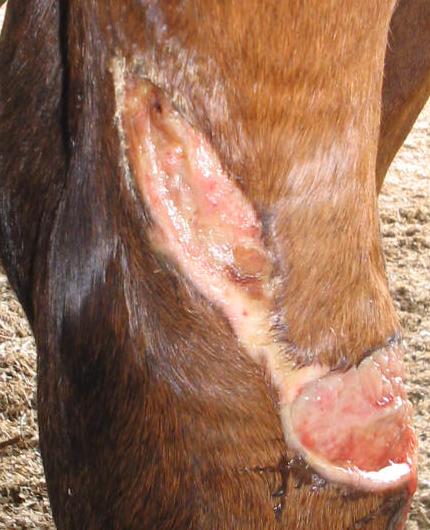 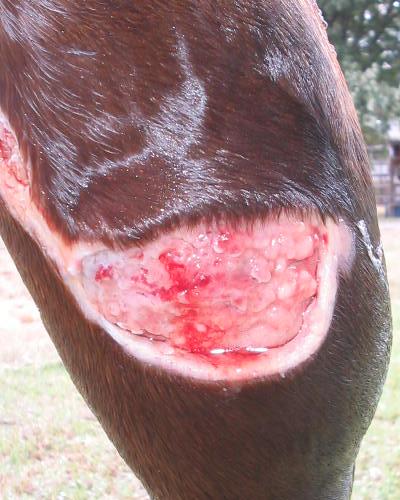 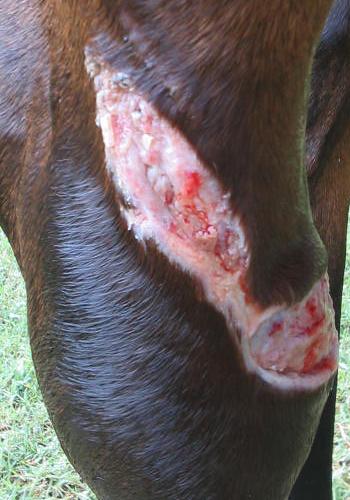
|
| Member: hwood |
Posted on Sunday, Sep 30, 2007 - 11:04 pm: Day 13 after hosing: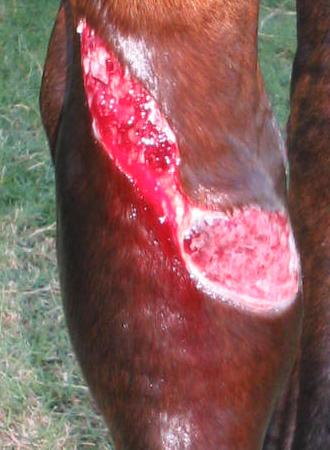 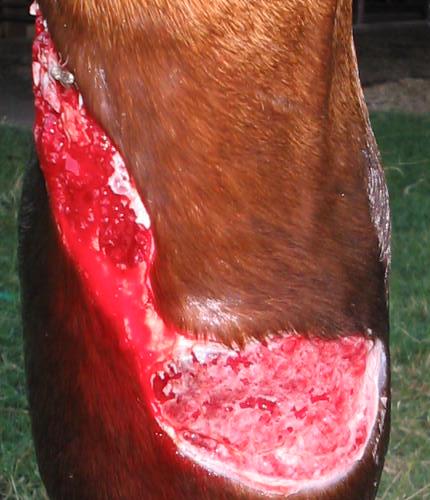 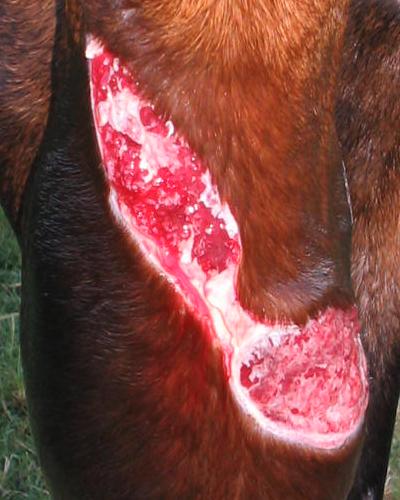 Quite a bit of whitish flesh shedded off during the hosing, and the flesh underneath was quite bloody. The lower wound doesn't seem to be filling in quite as much as the diagonal wound, yet. The vet didn't make it out last week, so is scheduled to come this Wednesday for vaccinations and will look at the wound at that time. He has already said that he wants to use the copper sulfate powder on the wound as it starts to heal. I think it is standard practice for him when there are deep wounds like this. Does the wound look as though I will need to use the caustic powder? |
| Member: zarr |
Posted on Monday, Oct 1, 2007 - 1:31 am: Hope with all the stuff out there now a days there is something other than copper sulfate, that just made me wince BIG time . It looks really good! You might e mail Theron and ask him what they used on Babe or that thread may still be here !!?? Cindy |
| Member: ajudson1 |
Posted on Monday, Oct 1, 2007 - 6:44 am: Holly,I think it looks like it's healing o.k. I think bleeding is also o.k., helps it clean out, unless it's really gushing blood of course. Why would you want to put something caustic on it? I don't understand that. Hope she's being good for you through all this. |
| Moderator: DrO |
Posted on Monday, Oct 1, 2007 - 7:16 am: The wound looks good Holly, I want you to reread our article on long term wound care as it addresses all the issues you raise. As the article will explain it is way too early to expect any wound closure with a wound of this type. The white material is not flesh, it is dried exudate.DrO |
| Member: hwood |
Posted on Monday, Oct 1, 2007 - 9:12 am: Thank you. I guess I thought that exudate would be slimy and liquid-y . . . not white and flaky. At first I wasn't sure if I should be blasting it off with the water, thinking, "I hope I'm not taking off good, new skin," but then figured if it was good skin, it wouldn't shed so easily. (I hoped.)At this point, I am still using nitrofurazone (vet wanted that instead of the triple anti-biotic ointment) and am bandaging the wound and wrapping her lower leg. She's moving well. I stopped the Bute a couple of days ago. I have Furall Spray and at what point should I switch to a dry dressing? I believe the Furall can still be bandaged, can't it? (I've only used it on smaller open wounds and have never used it under a bandage.) I wouldn't want the wound to be naked as I'm concerned about it getting banged. If the vet suggests switching to the caustic powder (which I already have since he prescribed it in treatment for a horse with a sliced heel bulb, coronet, and pastern last year) I will ask him if I can continue on the present course and if excessive proud flesh develops, if he will be agreeable to coming back to slice it off (or maybe Corinne can do it on one of her trips to and from OK . . . gotta keep her nurse skills "fresh.") Thank you, again. |
| Member: hpyhaulr |
Posted on Monday, Oct 1, 2007 - 12:22 pm: Holly, your progress is awesome, and I am grateful to you for posting the pix and progress as you have.... Just about 3 days after you began to post this, there was an accident right in front of my house. Fool # 1 slowed down to pull into the driveway next door (yes, even those 'expletive deleteds' have friends), Fool #2 driving a truck pulling a 4 horse trailer with 3 on board, was tailgating Fool #1. AS Fool #1 did not see the immediate benefits of turning on her turn signal, Fool #2 decided to pass her on the left and was completely surprised when Fool#1 turned into Fool #2. #1 went into the ditch on the left, #2 flipped the trailer and went into the ditch on the right. By the time I figured out that sound was NOT thunder, got the dogs in their cages and ran out grabbing my gloves and a couple of lead lines, I could hear a horse still thrashing about in the trailer and see the silouette of a girl and 2 horses in the headlights behind the accident. I led her horses into my stalls where I could start assessing the damage, while she got the last one brought in. I was immediately struck by the similarities in the wounds Holly posted and these horses' wounds and set about cold hosing. A few head gashes, but more upsetting to me were the numerous leg wounds. Clearly, this could have been MUCH worse. While I wish noone harm, the 2 fools who made the bad choices did not have a scratch on them and here there were bleeding horses in my barn, it just frosted my cookies. All they did was to get into the trailer as they were told and do their level best to stay calm and upright as their world tumbled out of control...Because of the wound similarities and Holly's posting of them, I knew to get to work coldhosing one in the barn cross ties while Courtney cold hosed another horse by the house. Within a half hour her mom was there and injected them with a bit of banamine and I expect, ace, before shock set in. They were all so well behaved (barrel racers) and I was impressed with how well they loaded up into the borrowed trailer to get home to their own barn. The accident happened at 9:30 pm, and they were on their way home by midnight.Way to go, Dr. O... if not for this site, I would not have known how to be as helpful as I was. And Holly, (former) perfect strangers from Laurel Hill,NC are grateful to you as well. as an aside.... my gelding QH Mac,and Bubba, our gelding donkey were in their pen and saw the whole thing happen. They were so upset for hours!. They were running in circles when I got outside, I am not sure if they were reacting to all the emergency lights, the screams of the horses trapped in the trailer, the adrenalin rush of the accident itself or seeing the other horses damaged... horses coming into their barn is a sight they are quite used to given our history of travelers staying here. My mares in the turnout, really could not have cared less, but the boys were VERY upset about it all. Follow up is positive, they all vetted out and are mending as well as can be expected. |
| Member: zarr |
Posted on Monday, Oct 1, 2007 - 6:58 pm: For all who gave Cyndy the knowledge needed at that moment in time, great job, and especially to you Cyndy for having a good head on your shoulders and the skill to apply said knowledge! Very lucky horses to bad about fools #1 and #2 !! Cindy !! Cindy
|
| Member: scooter |
Posted on Monday, Oct 1, 2007 - 8:40 pm: Holly the wound really does seem to be looking good! Do you let her move around or keep her stalled?This site is the best  . I even amaze my vet sometimes with the knowledge I have gained here. . I even amaze my vet sometimes with the knowledge I have gained here.
|
| Moderator: DrO |
Posted on Tuesday, Oct 2, 2007 - 1:34 pm: We know it is not new skin Holly because new skin cannot originate from granulation tissue. The only cells that can create new skin is the skin on the margins of the wound and yes when it forms you will not be able to hose it away.Though I prefer keeping the wound moist as long as possible as described in the article, you could switch to nitrofurazone spray at anytime. DrO |
| Member: hwood |
Posted on Tuesday, Oct 2, 2007 - 1:54 pm: Thank you. I haven't been able to locate Nolvasan cream, so am using Nitrofurazone, and since the article states that petroleum-based or glycol ointments can slow down the healing or encourage proud flesh, I was wondering if the Nitrofurazone (my jar is old and I can't read all the writing on it) has petroleum in it and if it would be better to go with a dryer dressing.If the Nitrofurazone ointment is good, then I will continue with it. |
| Member: hwood |
Posted on Tuesday, Oct 2, 2007 - 2:00 pm: I feel so unsure of my understanding after reading the articles, so went back to check.From article on Proud Flesh: "Ointments containing petroleum jelly or propylene glycol increase the rate of proud flesh formation." |
| Moderator: DrO |
Posted on Wednesday, Oct 3, 2007 - 7:05 pm: Though I cannot know what is in your jar Holly, most nf ointments contain propylene glycol. The question which of these lesser choices to choose and I do not have anything to judge which may be the better choice. Perhaps if the wound provides plenty of its own moisture you could you the spray otherwise the ointment.DrO |
| Member: hwood |
Posted on Wednesday, Oct 3, 2007 - 10:27 pm: So . . . even though the Nitrofurazone ointment may promote proud flesh more than if not used, it is better to keep the wound moist than dry so it doesn't crack?The vet came today and said it looked great . . . much better than he expected, and he said it is close to the contraction stage. I told him I'd rather not use the copper sulfate powder and would rather have him cut any pround flesh if it develops, and he said that the copper sulfate, may hurt some of the good skin cells, too, but is much better to use than cutting the proud flesh which creates more blood and more healing and more proud flesh and it becomes a vicious cycle and sets the healing back more than does the powder . . . and if the wound continues to do as well as it is doing, that the scarring will be minimal with the use of the powder. Presently, I am continuing with hosing, and wrapping after bandaging with the ointment. |
| Member: scooter |
Posted on Wednesday, Oct 3, 2007 - 10:49 pm: Holly quite a few years ago I had a mare with a very similar cut. I tried the wonder dust and it seemed to irritate the wound and "burn" when applied. Also had a hard time getting it on just the proud flesh.Vet then recommended "prouds off ointment" it worked very well seemed painless and I was able to apply it where I wanted it to go. Here's a link to it if you are interested. https://www.valleyvet.com/equine-topicals-ointments/Proudsoff |
| Member: hwood |
Posted on Wednesday, Oct 3, 2007 - 11:20 pm: Thanks, Diane. I'll check it out. I order from Valley Vet a few times a year, and it is great that they are here in KS because now, when I order, it arrives the next day. I'm leary of trying new medications unless a vet or friend has told me that it works for them. |
| Member: hwood |
Posted on Wednesday, Oct 3, 2007 - 11:27 pm: Diane, I see that I didn't answer your question about Dixie being stalled.She is in a 16 x 16 pipe panel stall under the roof of the barn. She is over the wall from a run-in that houses 5 geldings that can come under the same roof next to her. She routinely squeals and kicks (I told you she was b#$chy)at the geldings, especially at feeding time.  Yesterday, I let her out in the round pen so she could move around a bit more and graze some of the Bermuda that has sprung up around the pen. I know she rolls in the shavings in the stall a couple of times a day. When I hose her, I let her graze the grass outside the barn. Yesterday, I let her out in the round pen so she could move around a bit more and graze some of the Bermuda that has sprung up around the pen. I know she rolls in the shavings in the stall a couple of times a day. When I hose her, I let her graze the grass outside the barn.
|
| Member: ekaufman |
Posted on Wednesday, Oct 3, 2007 - 11:43 pm: Hi Holly,Sounds like you have a plan and great progress. Fort Dodge sells a Nolvasan ointment (available through Amazon (!) and other places). Looks like it comes in a giant vat, just in case. |
| Moderator: DrO |
Posted on Thursday, Oct 4, 2007 - 6:24 am: Does anyone know what is in the Proudsoff? The problem with a product like Proudsoff is that it claims to be able to distinguish healthy tissue from proud flesh. But proud flesh is nothing more than the exuberant growth of healthy granulation tissue, basically masses of cappilaries. A healthy bed of granulation tissue is needed for the skin to migrate across the wounds surface.DrO |
| Member: scooter |
Posted on Thursday, Oct 4, 2007 - 6:55 am: Other than the Cupric Sulfate, I don't know what is in it. I don't know what the "special base" is. Holly They do have a phone # listed on the label in valley vet if you would like to find out.I do remember it was green, and the small 3 oz. jar lasted forever. I ended up throwing out half the jar because it got old and dried up after a few years. The wound on the mare I had healed well without a scar. |
| Member: hwood |
Posted on Thursday, Oct 4, 2007 - 8:53 am: My vet was very pleased with the health and development of the granulation bed on Dixie's wound. If I have time after work tonight, I'll take a couple of photos.The vets at Valley Vet are quite helpful. I have called and asked questions regarding certain products and methods, and when the people taking the orders weren't able to answer the questions, they had the vets call me. A valuable "perk" in ordering from their company. The Prouds Off sounds like a compromise between keeping the wound moist while limiting the proud flesh. (+1-1=0?) I'll check it out. Thank you. |
| Member: ekaufman |
Posted on Thursday, Oct 4, 2007 - 8:56 am: Proudsoff is 49% copper sulfate, and 51% "special base" whatever that means. Seems like poor labeling-- by that logic everything could be labeled 100% "magical cure."I found the following key to various proud flesh products' active ingredients, none of which discusses the base: Copper sulfate E-Z Copper (SSI Corp.) Proudsoff (Creative Science) Copper sulfate, citric acid Copper Blue (AgriLabs) Copper sulfate, iodoform, tannic acid, activated charcoal, alum Wonder Dust Wound Powder (Farnam) Copper sulfate, phosphoric acid StepSept FB-T100 (BouMatic) |
| Moderator: DrO |
Posted on Thursday, Oct 4, 2007 - 8:56 pm: Copper sulfate is discussed in the article on proud flesh.DrO |
| Member: hwood |
Posted on Thursday, Oct 4, 2007 - 9:57 pm: Yesterday, Day 16, there was no bright red on the lower part of the injury. There was a tiny bit of purplish like bruising up in the top "corner" of the wider wound, and I was surprised at the angry redness of the wound today. The diagonal wound looks much the same as it did yesterday . . . the granulation tissue is consistent and level with the surrounding skin. The dark reddish skin in the lower wound is starting to raise above the surrounding skin.I did use a light powdering of proud flesh powder on some nitrofurazone coated gauze for that portion of the wound, and wrapped as I have been doing since the start. Maybe I made the wrong choice, but it seemed the right thing to do. Maybe the pressure of the padding and the bandage has irritated the front of the hock when Dixie bends her leg. I don't know. I tried to wrap it a bit looser today just in case it got too much pressure yesterday. Photos from Day 17 Before hosing: 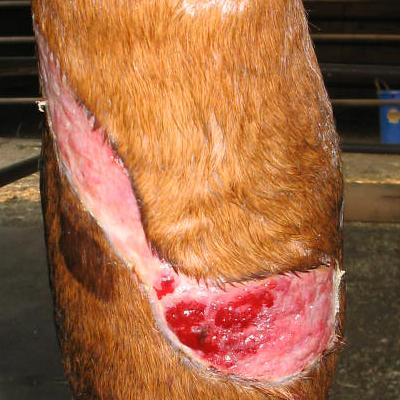 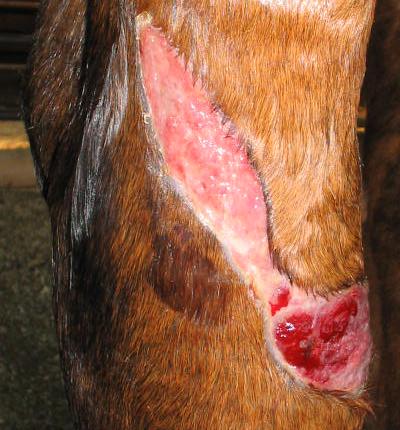 After hosing: 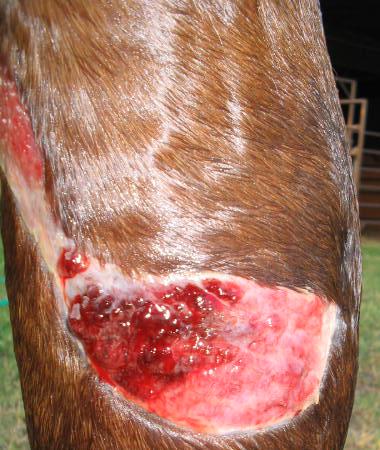 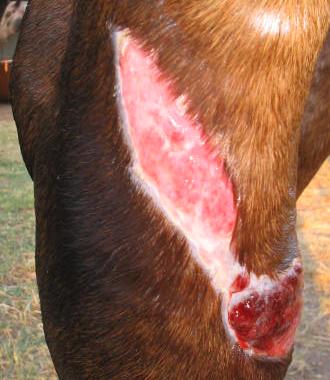 For Angie. Pictures of hock wrap and pressure wrap: 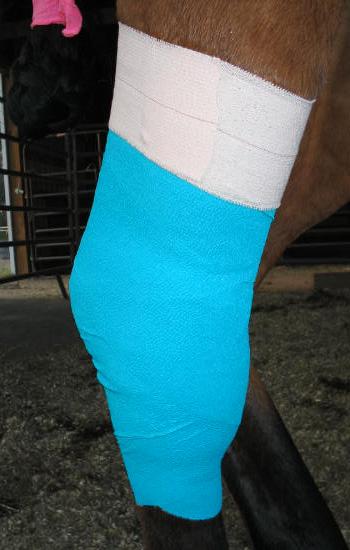 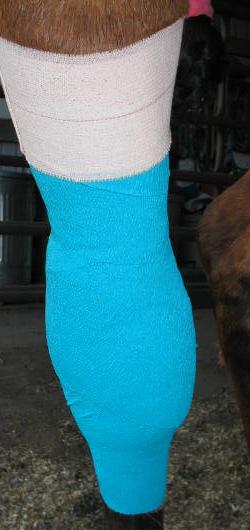 
|
| Member: hwood |
Posted on Friday, Oct 5, 2007 - 12:31 am: Question:Have any of you ever used Honey to combat Proud Flesh? https://www.woundade.com/?src=Adwords&campaign=1&adgroup=PF Also: https://www.associatedcontent.com/article/358557/honey_the_alternative_healing_me dicine.html "Wound care with honey? Yes, it is truly a wonder. My sister in law had a horse that had a wound that started mid chest and ran to the shoulder. She filled it with honey. And it healed with no proud flesh and barely a scar. She was thrilled with the results." |
| Member: shirl |
Posted on Friday, Oct 5, 2007 - 12:36 am: Holly Dear,All I can say is You Are Amazing! Shirl |
| Moderator: DrO |
Posted on Friday, Oct 5, 2007 - 7:32 am: Everytime you use a caustic medication Holly you slow healing and therefore increase scar size, I do not know how to make it plainer than that.I have not used honey for proud flesh and have not seen any work on such. Honey and hypertonic sugar has been used for decades, often in combination with other antimicrobials, on wounds and abscesses where increasing drainage and debridement is important. I am not sure how this applies to your wound however. DrO |
| Member: hwood |
Posted on Friday, Oct 5, 2007 - 8:21 am: I'm stuck between a rock and a hard place then, Dr. O., because my vet said that the cutting back of the proud flesh delays healing even more than the copper sulfate will and will make a bigger scar . . .As always, I am trying to do what is the best for my horses, and when I read things here, and ask questions, and then hear the opposite from the flesh and blood person who is tending my horse . . . well, it's aggravating, unsettling, and leaves me not knowing which way to go. |
| Member: hwood |
Posted on Friday, Oct 5, 2007 - 9:35 pm: Wasn't sure what I'd find when I removed the bandage today.Day 18 before hosing: |
| Member: hwood |
Posted on Friday, Oct 5, 2007 - 9:40 pm: Sorry . . . hit the wrong button.Day 18 before hosing: 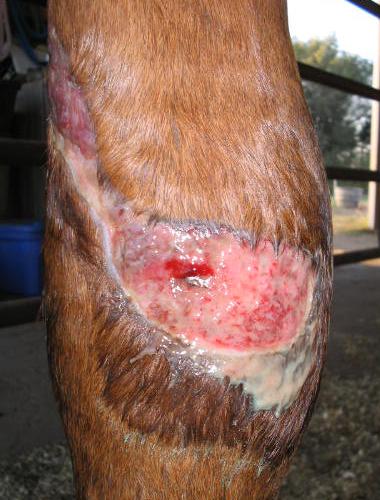 The bubbly red part was gone and the granulation tissue looked level again, but there was more bleeding on the surface of the lower wound than there was yesterday. Day 18 after hosing: 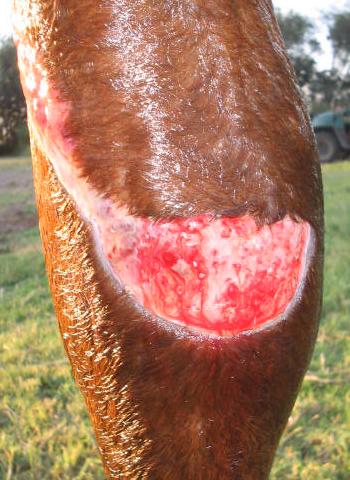 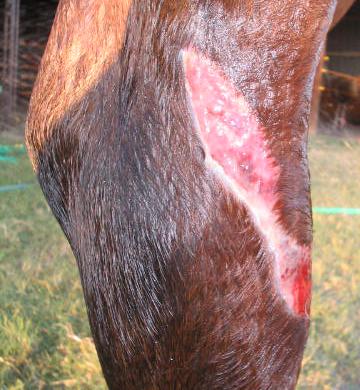
|
| Member: scooter |
Posted on Friday, Oct 5, 2007 - 9:51 pm: Don't you just love the rock and hard place, been there many times! You are a good enough horse woman to make the decision with the info provided you.The wound is looking very good so you must be doing something right. 
|
| Member: hwood |
Posted on Friday, Oct 5, 2007 - 10:39 pm:  Thanks, Diane. I've been told I think too much . . . by more than one person . . . just don't want to botch the healing of this wound and get a scar . . . for Mark's sake. Thanks, Diane. I've been told I think too much . . . by more than one person . . . just don't want to botch the healing of this wound and get a scar . . . for Mark's sake. Since I've read a lot about proud flesh and wounds and seen the photos of some horrendous ones, I'm not sure what I'm looking for. Reading about it is one thing but matching the words to real life is different . . . so when I get feedback from some of you who have seen these kinds of wounds, it helps me put it in perspective. |
| Member: scooter |
Posted on Friday, Oct 5, 2007 - 11:25 pm: Holly I haven't had a lower leg wound for years...I did have my share of them until I finally found a place without barbed wire.I have treated them with the proudsoff AND Dr.O.'s way with great success I had a small scar only once. I found Dr.O's way to be easiest, but involved a few vet calls $$. They do bleed like crazy, but did seem quite painless. Also the reason I asked if she was stalled, somewhere in the back of my mind it seems a vet once told me it is best for them to move around so the skin don't get too tight or something like that. So when they do start moving it don't rip apart?? Made sense at that time...so I put a thick shipping boot on over her wrap and turned her out with the rest of them. I don't know if that is correct but it worked for her. |
| Member: juliem |
Posted on Friday, Oct 5, 2007 - 11:49 pm: Holly, it's been my understanding that proud flesh would be above the level where the healthy tissue should be--is that right?? I haven't dealt with a wound like this YET (weanlings arrive next weekend! so I don't know. Anyway, your wound looks so good and it looks in the pictures as if it's all at the right level. What about doing nothing in regards to proud flesh until there is obvious tissue where it shouldn't be?? Sort of an "if it ain't broke" approach. You have done such a remarkable job, pat yourself on the back. I had a very bad pastern injury once and the vet had me wrapping it but not hosing (insisted he needed to be kept dry??). After three weeks he wanted me to bring him back as he was certain there would be proud flesh to remove. I said I didn't know what to look for, but didn't think I had any. He insisted that the location would certainly say I did have some. Anyway, when he saw it he agreed and said that was because of the diligent bandaging and pretty unusual. Maybe that's going to be your case! |
| Moderator: DrO |
Posted on Saturday, Oct 6, 2007 - 8:33 am: If your veterinarian is saying controlling proud flesh with cauterants is better than no control that would be true but if he is saying it is better than controlling with appropriate surgical removal, he is just plain wrong according to everything I have ever read, my experience, and commone sense.First you should note you cannot get any full skin thickness wound healed with second intention healing without some amount of scar and the front of the hocks are the worse to scar because of the motion there. No matter your course there will be a scar here. The question is how to make it as functional and aesthetic as possible. The quicker the wound heals the smaller the scar. Cauterization works by killing tissue indiscrimately, this includes the tissues trying to cover the defect. This includes Diane's Proudsoff which is just like many other proud flesh cauterants. Diane you can heal wounds with this stuff but what ever small scar you were left with would have been smaller with surgical debridement. And if there is no scar it was not a full skin thickness wound. DrO |
| Member: hwood |
Posted on Saturday, Oct 6, 2007 - 9:13 am: Yes, Dr. O. That is what the vet said. I told him I'd rather not use the Copper Sulfate powder and have him come and cut the proud flesh if it develops, and he said that the tiny percentage of healthy cells the powder inhibits is much less than the invasive cutting of the proud flesh and the subsequent bleeding, and that I should trust him that the powder will heal it much better and faster with less of a scar . . . and that he'd seen it many times.It's a rather difficult spot for me to be. I am not experienced at cutting the flesh myself, or I could just say, "well, I won't contact him again for this wound and will just handle it myself." If the flesh needs to be cut, I have to have him do it, and if he believes he's not doing the best thing for the horse, then ?? Julie, the bubbly, dark red flesh was above the edges of the wound on Day 17, but yesterday, when I removed the bandage it was gone and the surface was level again. I didn't use any powder last night. Actually, I used a bit of honey with the nitrofurazone when I rewrapped. Figured it won't burn anything and will either help or do nothing. |
| Member: scooter |
Posted on Saturday, Oct 6, 2007 - 9:16 am: Well Holly that pretty much ans. it, If you want to minimize scarring I would go with the surgical debridement...it does make more sense.
|
| Member: ajudson1 |
Posted on Saturday, Oct 6, 2007 - 10:09 am: Holly,Thanks for the pictures, I cannot wrap a leg that nicely. I just checked my new horse health "bible"..All Horse Systems Go. The agreement is with DrO in there on wound care. (DrO should publish a book, don't you think?) "Caustic Chemicals like copper sulfate, bleach, lye and similar caustic agents chemically cauterize proud flesh, but also damage migrating skin cells and slow healing." (not word for word) "It is better to surgical remove proud flesh than to resort to chemical irritants. Caustic substances cause tissue death, with redevelopment of proud flesh that persists as a non-healing, grotesque wound." (word for word, page 416) I don't see anything there that needs cutting. I would just keep hosing it, and perhaps rub with a soft rubber curry comb of some sort if I thought something had to come off. Or pick at it with my fingers. Very good info on the use of honey, (unprocessed honey) and granulated sugar. Says Nitrofurazone contribute to the formation of proud flesh on deep wounds, delays healing by 30% but helps superficial skin abrasion. I did not know that! Looks like your are in need of an early Christmas present girl friend! You're giving her great care, relax. |
| Moderator: DrO |
Posted on Saturday, Oct 6, 2007 - 11:57 am: Holly I would like to see the work that supports his supposition but given a choice of help from your veterinarian or trying to go this with written advice by those who cannot examine the horse you should choose your veterinarian there are dozens of ways you can go wrong and there may be complications all of which could be more significant than the differences between surgical and cauterant therapy.DrO PS Angie, I have written a book and you are looking at it. It just happens to be published on the internet, updated and expanded daily, and you can ask it questions and expect a answer. |
| Member: maggienm |
Posted on Saturday, Oct 6, 2007 - 12:29 pm: HollyThank you for posting about this wound, I know I have been educated. I have read all posts and learned, while I hope I never have to put any of this into practice I will be much better able to now. In a quick search I found a bit about using honey on wounds. The folowing is from https://www.dermnetnz.org/nzds.html In most cases, honey is used when conventional antibacterial treatment with antibiotics and antiseptics are ineffective. Numerous studies have shown that these difficult-to-heal wounds respond well to honey dressings. Inflammation, swelling and pain rapidly subside, unpleasant odours stop, debridement is enhanced as the honey dressings remove dead tissue painlessly and without causing damage to the regrowing cells. Honey promotes rapid healing with minimal scarring. Honey can also be used as first aid treatment for burns as it has potent anti-inflammatory activity. Also; Fifty-nine people with chronic wounds and ulcers participated in one preliminary study described in this review. The group included people with diabetic ulcers, burns, traumatic ulcers, gangrene, and other types of wounds. All had been treated with commercial wound dressings and antibiotics for periods of between one month and two years without results. Although 51 of the 59 wounds had been infected prior to honey treatment, all were free of infection within one week of starting honey dressing applications. In addition, inflammation and odor were markedly reduced and healing rapidly ensued; this cam from healthnotes newswire. Of course, I am also familiar with the saying if it sounds to good to be true it probably is. |
| Member: vickiann |
Posted on Saturday, Oct 6, 2007 - 12:51 pm: My Vet recommended Granulex for elimination of deleterious tissue -- worked great. For information, go to:https://www.pfizerah.com/product_overview.asp?drug=GV&country=US&lang=EN&species= EQ I don't like the idea of Wonder Dust much, and wouldn't want a horse to rub that stuff into the eye. Maybe your situation is too far gone for this product to work on any well-established proud flesh, but might prevent additional proud flesh from developing. I don't even have scars after using the Granulex. The wounds I dealt with were deep and bad, though not as large. |
| Member: hwood |
Posted on Saturday, Oct 6, 2007 - 12:59 pm: If I feel I can press the issue with him, Dr. O., without sounding snooty, I'll ask him about the research. Don't know if it's just annecdotal or scientific. He is a really caring fellow; not cocky. Very "into" all the specifics, and if I ask a question, he will sincerely try to explain the medical reasons as best as he can. He was raised in this state and has seen tons of barbed wire cuts and cuts from metal siding on buildings. He is one of the few vets in this area who does all large animals and small. He just returned from a few days of classes at the university . . . to keep up his license/certification or something.Maybe I'll just toss the nitrofurazone (if it encourages proud flesh growth) and just use honey and see what happens. Dr. O., are you familiar with something called neopredif? |
| Member: hwood |
Posted on Saturday, Oct 6, 2007 - 1:03 pm: Is Granulex a copper sulfate medication?Oh, and "thank you," to you members who are providing all the extra information on pharaceuticals and excising methods. I really appreciate your time, research, and concern. |
| Member: hwood |
Posted on Saturday, Oct 6, 2007 - 1:41 pm: Vicki, I went to the Pfizer site and saw that the main ingredient in Granulex is trypsin. I remember that the vet in CO always recommended that for all the wounds on the horses at the ranch there.Thank you. |
| Member: hwood |
Posted on Saturday, Oct 6, 2007 - 2:00 pm: Been reading about Trypsin after a Google search:dissolves protein . . . does it distinguish "good skin" from "skin gone wild?" |
| Member: vickiann |
Posted on Saturday, Oct 6, 2007 - 2:05 pm: This shows as ingredients:GRANULEX® V(trypsin, crystalline, N.F; balsam peru, N.F; castor oil, USP) I am relieved you are having success healing this wound Holly, and hope you will have steady progress toward an excellent outcome. When I originally saw the wound I immediately thought "proud flesh" and "Granulex" but was not sure I should send that suggestion early on with the size of the wound. I felt that this wound needed some other professionally recommended treatment in the early stages. Maybe at this stage the Granulex would be appropriate and perhaps Dr. O will have some comment on this possibility. Good luck. |
| Member: vickiann |
Posted on Saturday, Oct 6, 2007 - 2:21 pm: If I recall correctly, you want to spray this product on the wound but keep or rinse it off the area outside the wound as much as is practicable. In my experience, the job it did at cleaning up and healing the wound was pretty amazing, and I didn't feel that it set back the healing overall by eating up good tissue to any great degree. |
| Member: hwood |
Posted on Saturday, Oct 6, 2007 - 11:57 pm: For anyone who is interested in following the healing:Day 19 before hosing: 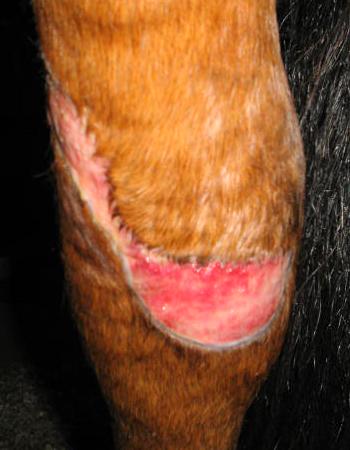 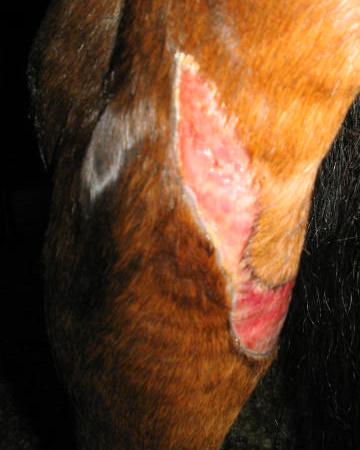 Camera batteries died, so didn't get any after hosing photos, but the wound looked much the same after hosing. I wrapped with honey on top of nitrofurazone-smeared gauze. |
| Member: hwood |
Posted on Saturday, Oct 6, 2007 - 11:58 pm: Vicki, do you remember when in the healing process did you start using the Granulex? |
| Member: paul303 |
Posted on Sunday, Oct 7, 2007 - 12:21 am: Trypsin is a digestive enzyme, I believe. Almost sounds like the Accent remedy for proud flesh. Might be a bit harsh. I have to agree with Angie. It doesn't look like it needs anything cut and you should just continue with what you're doing...it's working so far. After all, you can't treat proud flesh until you've got some.I also agree with Angie that I can't wrap a leg that nicely, either. The turn of your neatly wrapped bandage is very slimming with the tone on tone seafoam hue of the bandages playing up the burnished chestnutty tint of the leg. Your taste in bandage is exquisite! I wish I looked 1/4 as fashionable in my barn clothes as your mare looks in her bandages. |
| Member: hwood |
Posted on Sunday, Oct 7, 2007 - 3:06 am: No, no, guys. Don't worry. I'm not going to treat proud flesh that isn't there. I used a smidgeon of powder the other night because there was a start to some proud flesh-looking tissue, but it's gone now, so I'm just going along as I was ('cept for the honey, which is a pain in the neck to spread. You know the saying, "You catch more flies with honey?" grrrrrrrrr)Lee, you crack me up. Come clean with us now. You really used to write for a fashion mag, didn't you? No wonder you are so accomplished with your descriptions. |
| Moderator: DrO |
Posted on Sunday, Oct 7, 2007 - 9:07 am: Granulex is primarily used to debride away dead tissue through enzymatic digestion and to jump start the granulation tissue is not really for use in already clean well healing wounds.And Holly why would you want to experiment with honey on a large wound on your horse's hock? Though sugar has been used in the early treatment of wounds as described above, mainly for its strong osmotic properties, I have never seen its recommendation for clean well healing wounds and it will not have any known beneficial effect on proud flesh that I am aware of. In fact it's early use is one of promoting granulation tissue, an important first step to healing. DrO |
| Member: hwood |
Posted on Sunday, Oct 7, 2007 - 9:20 am: Well, I thought honey might be more gentle and less encouraging of proud flesh, since reading that wounds in which honey was used didn't develop proud flesh and since reading that nitrofurazone may promote proud flesh. |
| Member: corinne |
Posted on Sunday, Oct 7, 2007 - 12:04 pm: Holly....Your wound looks wonderful and you are doing everything correctly. It's been wrapped when I have seen it but the day 19 healing looks like proud flesh is not going to be an issue so I would stop my focus on that. I think the cold water lavaging is the best bet for you! Good work on the wound care....it looks fabulous! |
| Member: hwood |
Posted on Sunday, Oct 7, 2007 - 1:05 pm: Thanks, Corinne. I hope that Dr. O. feels the same. I have been expecting proud flesh to develop because no one has told me that it could heal without it. I have tried to be proactive and preventive in my treatment . . . and it may not seem that way to some, but if I can avoid any proud flesh from forming, I'd like to do so since my vet doesn't want to excise it and you might not be around to rescue me when I need a surgeon. |
| Member: vickiann |
Posted on Sunday, Oct 7, 2007 - 1:18 pm: Holly, the first time I used Granulex was upon a Vet's advice, immediately after he removed a hard cast (put on in error by another vet when I was out of town!) from a horse's foot. The cast had been on long enough to have begun to rub the leg, resulting in an extremely ugly situation inside the hot cast, in hot, humid weather. Other times since I've used it within a couple or a few days of other treatment depending upon how the wound looked. Along with removing the necrotic tissue, like Dr. O says, and as the name implies, it facilitates the filling in of the wound. It has helped me with a variety of nasty, deep leg wounds, and a bad hoof avulsion (torn off outer heel portion of the hoof, including coronet band). Over the years, one tends to develop an eye for what is or isn't working as a wound is going through the healing process. |
| Member: corinne |
Posted on Sunday, Oct 7, 2007 - 1:37 pm: I have had wounds heal without proud flesh and some with it. The more I was able to cold hose the less likely it developed. Perhaps yours will do the same. I really love how it looks, without a hint of proud flesh so far. Trust yourself that you are doing well. Once again, what ever you are doing, is working so far. Keep up the good work! And I doubt you will need rescuing...remember that's what I have you for.....for Demetrius' procedures on the 22nd.Either way, between the both of us and HA and Dr. O, I am sure our horses will come out unscathed from wounds and or procedures. LOL I think we just both have a lot of things on our plates and are projecting worries so we don't have to worry about other things....so it's nice we have each other to keep us grounded....ie....or else I might have tried to freeze Demetrius bellybutton thinking it was a melanoma! LOL You are a strong strong strong soul. You too are my hero~ Your wound looks great and your should be proud that you have gotten Dixire this far without any complications! You go my friend you go! |
| Member: hwood |
Posted on Sunday, Oct 7, 2007 - 5:28 pm: "When I am weak, then I am strong." Isn't that how it goes?Wow, thanks. I didn't know a wound like this could heal without proud flesh. The vet expected it the day he saw the wound and told me right away, and then two weeks later, that I'd have to use the copper sulfate once it appeared. I've been waiting and dreading for it to appear and thinking that it would get ahead of me. |
| Member: hpyhaulr |
Posted on Monday, Oct 8, 2007 - 9:28 am: Good Lord Holly, Are you sleeping at all??? I doubt it. Your regular chores, your diligent "Nurse Nancy" routine, research and pictorial history of this magnitude???? Factor in grief time and your clock calendar clearly exceeds the 24 hours the rest of us mere mortals have in our day....I sincerely hope you are taking care of yourself at least as well as you are taking care of everyone else...
|
| Member: hwood |
Posted on Monday, Oct 8, 2007 - 10:10 pm: I don't sleep as much as I used to, but am getting by. Taking the photos is no problem as I have to hose and rewrap everyday anyway. Don't worry . . . I'm a mere mortal, too . . . and as is oftentimes found in life, if there's a will, there's a way.I am not sure of what I am seeing, so I will appreciate enlightenment from some of you who have more experience with deep wounds. My questions are: What am I seeing on day 20 and 21? Day 19 looked fabulous, but there was quite a change yesterday, and the surface of the wound looks to be "bubbling" where it is deep red and raising above the edges of the wound a tiny bit. Also, what should I be doing, if anything? If this is normal healing and everything is good, then I will continue with the Fura-zone, bandaging and hosing. If something needs to change, please tell me what I should do tomorrow. Thank you. Day 20: 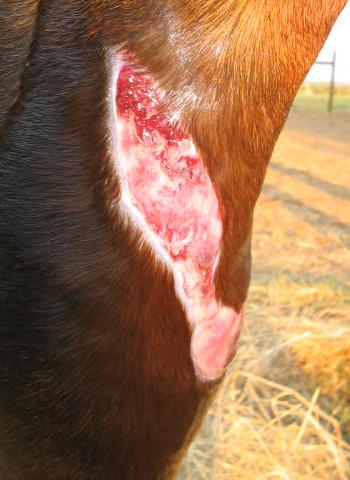 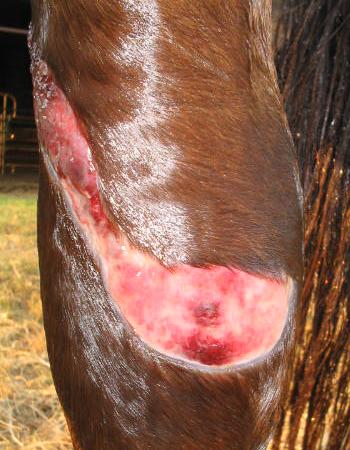 Day 21: 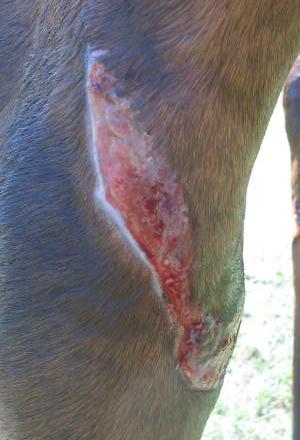 Dark purplish flesh has reappeared in the "corner" of the wound. 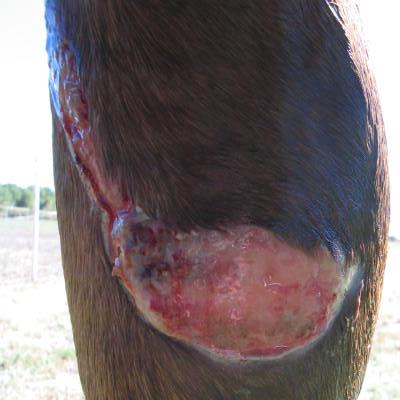 The next is a profile picture to show the elevation of the granulation tissue. 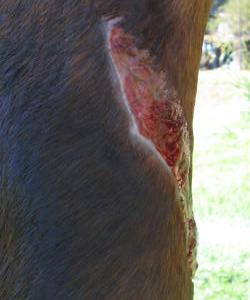 Could the Fura-Zone be responsible for this change? Will a collagen cream be better? |
| Member: hwood |
Posted on Tuesday, Oct 9, 2007 - 10:46 pm: I got two private responses to my previous post. Both wondered about leaving the wound uncovered at this point. I would like your opinion of that, please, Dr. O., as best as you can tell from the condition of the wound. Also, since there was more prominent growth of tissue after removing the bandage tonight, I stopped using the Furazone and started using some collasate gel that says it helps prevent proud flesh.The first picture is of a brush I have used to "scrub" the wound a couple of times. 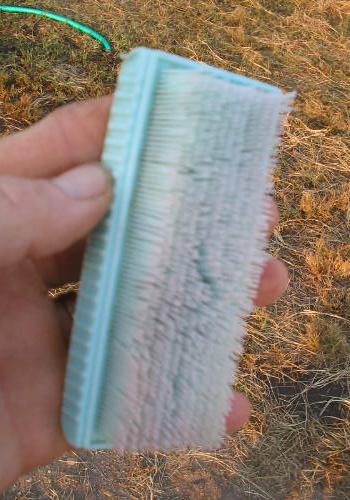 Day 22 before hosing: 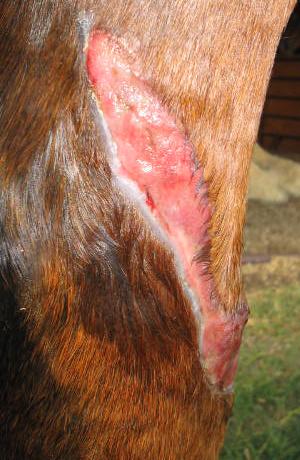 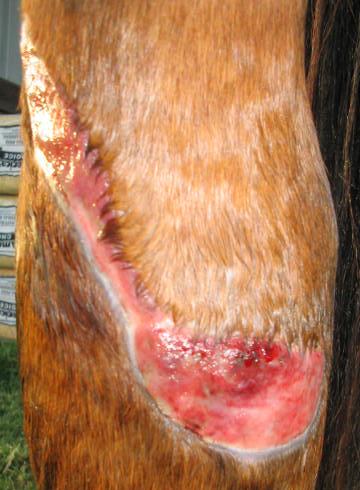 Day 22 after hosing: 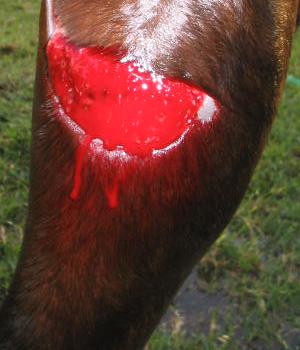 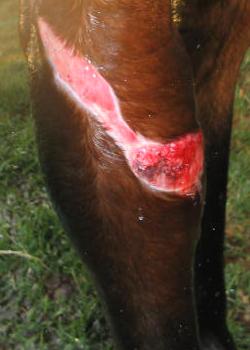 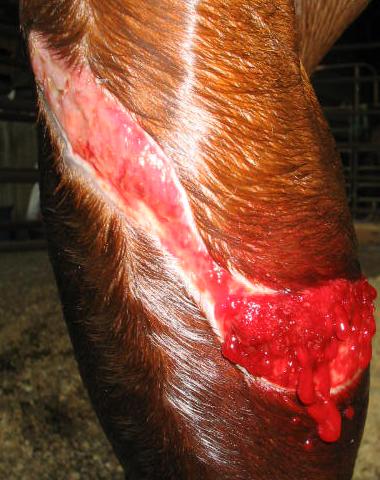 There was quite a lot of blood tonight . . . The more prominent flesh in the wound bled under the spray and took quite a while to start clotting. Is this how it's supposed to look as it progresses in it's healing? |
| Member: dres |
Posted on Tuesday, Oct 9, 2007 - 11:26 pm: Don't know but think it still needs to be wrapped..On the first day God created horses, on the second day he painted them with spots.. |
| Moderator: DrO |
Posted on Wednesday, Oct 10, 2007 - 6:27 am: The wound looks fine Holly, yes it is normal to have areas that appear bruised and you are getting a bit of exuberant granulation tissue. I don't typically scrub the wound with anything other than the hose.This wound could be finished healed either open or closed at this point. You may have a little less problem with proud flesh if you quit bandaging, if the wound stays clean unbandaged. In this location the bandage also helps limit range of motion so if without the bandage the horse flexes it much more it may do better with it on. It really is a bit of a coin toss. DrO |
| Member: hwood |
Posted on Wednesday, Oct 10, 2007 - 8:48 am: Whew . . . thank you, Dr. O. It seems to look so ABnormal to me, and after looking so good and smooth and clean to looking bumpy purple/red and bloody with just hosing . . .One friend asked if the wound was trying to "scab." I didn't think about scabbing, and maybe it's trying to do so. I will leave it unbandaged today and just apply some EMT GEL which is "Natural HyDrOlysate of Collagen" (looks like and has the consistency of honey but comes in a tube). The indications include traumatic (flesh tear) wounds, and the gel "reduces bleeding by sealing forming a plug to encourae natural clotting; seals off nerve endings to reduce pain and itching; forms a semi-occlusive barrier that protects the wound and provides a moist environment which encourages healing." The only ingredients listed are: Type I hyDrOlyzed collagen and Purified Water. Thanks, again. All the blood made it look to me as if the healing was going backward instead of forward. |
| Member: vickiann |
Posted on Wednesday, Oct 10, 2007 - 7:37 pm: Holly, I bought some of that EMT thinking it sounded fantastic, but found it healed the wound on the outside but NOT the inside, so hope your experience with it is better than mine was. I never used it much after purchasing it. Sometimes with deep wounds that need to granulate and close up, I've used Alu-Shield to keep it clean but still breathing. It is a spray on type of bandage. |
| Member: hwood |
Posted on Wednesday, Oct 10, 2007 - 10:29 pm: Thank you, Vicki. I did use the gel under the bandage last night, and today, I left it unwrapped but put the gel on after rinsing and let Dixie out in a small pasture for about 5 hours. I left it unwrapped for tonight. We'll see what happens. At least, I know now that the purple/red/bloody flesh is not a necessarily bad sign. Funny how it goes from looking smooth and pink and then red and inflamed and bumpy, and then back to smooth and pink again.I don't know if the "one good contraction" happened yet, or not. The diagonal wound does seem a bit smaller but I don't know when the contraction is supposed to happen and how small it will make the wound. Day 23: 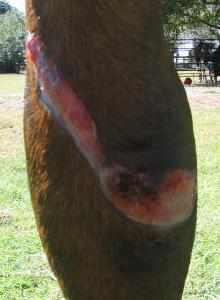 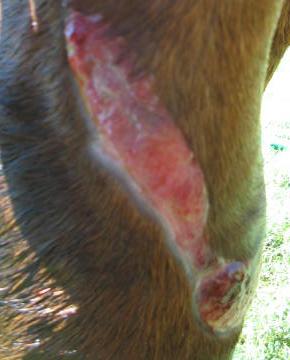 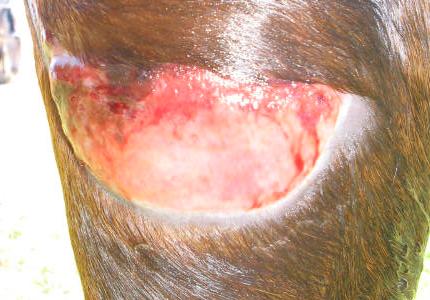
|
| Member: vickiann |
Posted on Thursday, Oct 11, 2007 - 12:16 pm: Good luck, Holly. With your diligence, you will have a good outcome. |
| Member: hwood |
Posted on Thursday, Oct 11, 2007 - 7:15 pm: Thank you, Vicki.This is Day 24 after 24 hours unwrapped and with the EMT Gel applied 24 hours before. I wish I had stopped wrapping a couple of days before, and may have been able to avoid the dark "exuberent tissue growth." I hope there is no "next time," but if there is, I will know better what to do. Day 24 with EMT Gel applied 24 hours before: 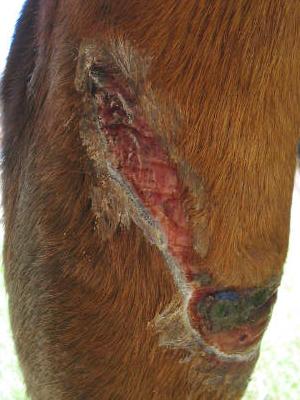 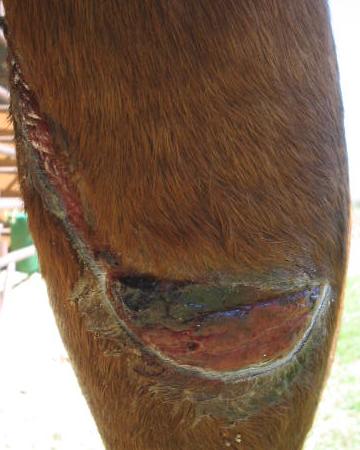
|
| Member: ajudson1 |
Posted on Friday, Oct 12, 2007 - 8:35 am: Looks Great Holly! Although it seemed like a long time healing, when you consider how it looked at the beginning, it's really amazing how fast it healed! |
| Member: maggienm |
Posted on Friday, Oct 12, 2007 - 9:48 am: Holly, again I thank you for your careful explanations and pictures. This is a most valuable document on wound care.How is the mare handling all the care to her wound? Is she still happy to see you? |
| Moderator: DrO |
Posted on Friday, Oct 12, 2007 - 5:26 pm: Holly the dark areas in your latest images were not caused by the wrapping but look more like areas that have been treated with caustic substances, it may be the lighting though. You have not had a significant contraction phase yet the article gives you a time frame for it but the larger the wound the longer it takes to occur. However I have never used EMT gel so do not know what to expect from it.DrO |
| Member: hwood |
Posted on Saturday, Oct 13, 2007 - 12:00 am: Lori, Dixie hasn't been a problem for any of the wound care. She looks forward to the hosing, because I let her graze free as I hose her leg. She does seem tender to pressure on the inside of the lower wound, and sometimes lifts her leg as I place gauze on it, or when I touch it to put the gel on it, but she is very easy to work on. Actually, all of my guys are good with their legs. I trim them all myself, so they are used to me working on their legs.Dr. O., there was some dark red bubbly flesh on day 17, so I used a very light dusting of copper sulfate powder on gauze that had been coated with furazone. On day 18, the bubbling was gone and the flesh was level and smooth. Only one other time I used some copper sulfate. The bubbly, purplish flesh appeared on day 21 and I used a light dusting of copper sulfate again that night, but on day 22, it didn't look better. That was the only other time I used the powder. I used the debridement brush on the wound the first day to clean it with betadine scrub, and then I used it on day 21 to see if it would get rid of the exuberant tissue. Those were the only two times I used the brush. Today is day 25. This is the second day the wound has stayed unwrapped. I hosed it and put EMT Gel on it again, but put the pressure wrap on her lower leg during the day. Her lower leg has looked swollen, even though the hock wrap has been off. Here is the wound at Day 25 before hosing: 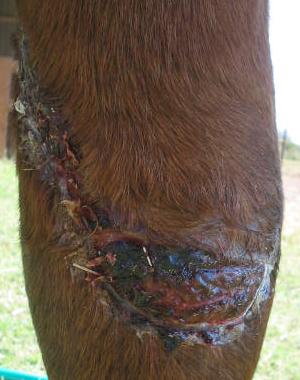  I thought the wound looked smaller. I guess I don't know what the contraction looks like. Day 25 after hosing: 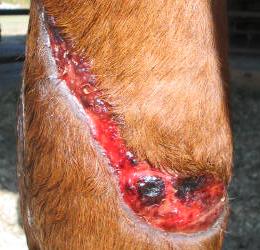 Day 25 lower leg: 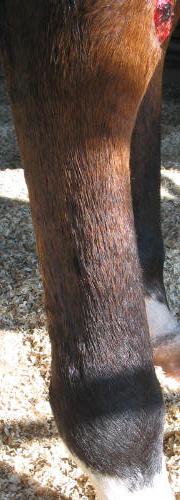 Thank you for your comments and help. |
| Member: paul303 |
Posted on Saturday, Oct 13, 2007 - 1:33 am: It just really looks good, Holly. Is she laying down at all? It sure doesn't look like she's using it for scrabbling around in the dirt to get up. Nice job! |
| Moderator: DrO |
Posted on Saturday, Oct 13, 2007 - 8:30 am: You still have what appears to be granulation tissue dying and forming a thin eschar on the surface, that is what the greensigh/black material is. I am uncertain why this is but the first two things that occur to me are you may still be seeing effects from the toxic copper sulfate or it may be excessive drying from current therapy. But as long as it is just the granulation bed the wound will heal but this may also represent areas of slowed down reepithealization at the skin margin and therefore a larger scar.When it contracts it will be significantly less wide, maybe 1/2 the size but you may have several weeks before this occurs. DrO |
| Member: hwood |
Posted on Saturday, Oct 13, 2007 - 10:03 am: Thank you, Dr. O.If this wound was on your favorite horse, what would you do to it at this point? I stopped wrapping to see if that would relieve any binding/friction on the larger part of the wound. Upon close examination, it seems that there are horizontal striations across the lower wound, so I think the bandage was binding, even though I tried to wrap it as carefully as possible. Yes, Lee, Dixie lies down and rolls. I often find her covered with wood shavings in the morning. Is scabbing a good thing? Should the two, dark, round scabs be removed or should I leave them alone? I have some corticosteroid powder (Neopredef) that was sent by a friend, and if you think this wound is a candidate for it, I will use it. I don't see any proud flesh forming since I stopped wrapping the wound and using the nitrofurazone. |
| Member: hwood |
Posted on Saturday, Oct 13, 2007 - 12:20 pm: After thinking about my question, I think I can hear you, Dr. O., saying, "My prescription for treatment is in the article, Holly," but I'm asking specifically, Dr. O. What would you do today, if you saw the wound looking as it does, to get what you will hope to be the best possible outcome? |
| Member: vickiann |
Posted on Saturday, Oct 13, 2007 - 5:56 pm: Swelling/stocking up of that lower leg looks frightening to me, Holly, though certainly do not want to be an alarmist and am not a Vet or really qualified to comment. If this horse belonged to me I would be wondering whether oral antibiotics are indicated? If I could see the inside leg, would know more. Is there any definition in the shape of the lower leg on the inside or is it all swollen? |
| Member: hwood |
Posted on Saturday, Oct 13, 2007 - 6:21 pm: The leg goes down to normal after wrapping, so I never thought of infection. I will wrap it again tonight. Left the wrap off for the day. I will take her temp tonight, Vicki, and keep an eye on it.Thank you. |
| Member: vickiann |
Posted on Saturday, Oct 13, 2007 - 9:09 pm: Good news, Holly. One of mine got a leg infection to the lower leg after I removed a scab. Got the Vet out and had to give oral antibiotics twice daily plus scrubbing, cleaning and treating the area twice daily. Sounds like you are on top of things, but hate to see the leg swollen so much that definition is absent, but if it goes down after wrapping, that is different. |
| Member: hwood |
Posted on Saturday, Oct 13, 2007 - 10:17 pm: Dixie's temp was under 100 tonight. I put the pressure wrap back on tonight as it had been off for 24 hours and her leg was stocked up. She is eating fine and doesn't act sick, but I saw her try to take a trot or canter step the other day when I had her turned out. She saw me and knew it was feeding time, so was coming toward the gate. She couldn't take the step normally and ended up hopping on that right hind leg.Dr. O. would you give Bute for the stocking up or would you just continue to pressure wrap? I have heard that when one leg is wrapped, the corresponding leg should also be wrapped. I have also heard that it isn't necessary to do so. What is your practice? |
| Member: scooter |
Posted on Sunday, Oct 14, 2007 - 10:10 am: Holly, From the experience I had at an equestrian barn...they always wrapped the opposite leg for support. If Dixie is weight bearing well on the injured leg it probably wouldn't be necessary, but if she isn't I would be inclined to support the opposite leg. I know I found out compensation lameness can be almost as bad as the original injury. Just MHO. |
| Member: hwood |
Posted on Sunday, Oct 14, 2007 - 12:24 pm: Thanks, Diane. I wrapped her last night, and this morning, her leg is much thinner, but she has some swelling on the inside of her hock joint, so maybe that is slowing down the circulation in her lower leg. I gave her one Bute today to see if it might help, and I unwrapped her about an hour ago. She is in a large area where she can move around for a few hours, and I saw her trying to get up from rolling as I was leading horses back from the pasture, and she was sitting on her right hind and had a bit of trouble getting it out from under her to get up. The lower leg was wrapped at that time. As she walked away from the rolling spot, she was very off on her right hind for a few steps. The vet said that her joint capsule was intact . . . but something is very sore on the inside of the joint, and is going to take a while to get back to normal if it can.Her left hind seems to be holding up very well and isn't stocked up at all, but maybe I should wrap it just to give her some extra support back there. |
| Moderator: DrO |
Posted on Sunday, Oct 14, 2007 - 12:40 pm: I would continue wrapping the lower leg for the swelling Holly by controlling it now you help keep this swelling from becoming chronic. I know DianeE that wrapping the other leg is traditional but standing bandages do not really offer any support and I would not expect Holly's horse to be much more than a little stiff on the wounded leg. It would surprise me if the swelling (dependent edema secondary to the open wound) is very bute responsive but if 1 gram 2 times daily makes a big difference I would continue it in my horse.Holly there is a lot to go into to decide whether to bandage or not and most wounds of this type can be healed up either way. Heck if you do everything wrong it will still heal from here. The question is how to make it heal as functional as possible. I have edited the "First Month" subtopic in the Long Term Wound Care article by adding an additional paragraph that goes into more detail on deciding whether to bandage or not. Review it, along with the whole article, and see if it does not address your concerns. There is just not enough information for me know would I keep bandaging at this point and any decision could change in response to changes in the wound. DrO |
| Member: hwood |
Posted on Monday, Oct 15, 2007 - 12:12 am: Your answer has helped me a lot, Dr. O. Thank you.I didn't read the answer until later in the day, and had Dixie turned out all day without any bandage or leg wrap. When I brought her into her big stall tonight, her lower leg looked much thinner, so maybe the Bute helped, or maybe it is just that she moved around today more than usual. I put a foam/fleece quilt and polo wrap on her leg tonight and gave her a Bute tab in her evening grain. The wound was dry and scabbed. I had hosed it yesterday and "poofed" some Neopredef powder on it, and then covered it with a layer of Fura-Zone to see if it would moisten it. It really looked no different today, but it didn't get any worse. Today, I left it alone until this evening when I put some Tri-Care ointment on it just to see if it would moisten it and keep it from cracking. The EMT Gel did create a film over the wound when it was moist. I don't think it would help on a scabbed wound. I will read the article on Long Term Wound Care again. Thank you. |
| Member: hwood |
Posted on Friday, Oct 19, 2007 - 9:28 pm: Just for the sake of interest in the progression of healing, this is taken at Day 30.I haven't hosed it for 4 days as it was scabbed and I didn't know if I should try to remove the scab. Today, I hosed it to see what would happen, and the scab peeled off under the water pressure. If you can picture this wound with a dark brownish/red, dry, cracked scab, that is what it was like before I hosed it. 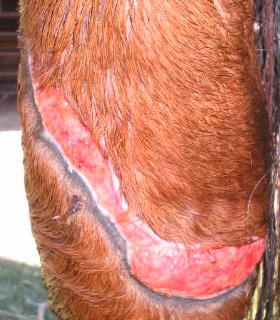 Dr. O., I know it may be hard to tell from the photo, but can you describe what the wound is doing now? Is this good healing or proud flesh? When Dixie is turned out all day, there is no swelling evident in her leg. Thank you all for your encouragement and help. When I was a kid, we just sprayed the barbed wire cuts with Blu-Cote and let them heal . . . I have been very conscious that there are better ways, and have tried to do it "right" thinking that if I did it the "right" way that I'd have no scarring. Methinks that maybe there is no "right" way, just better ways than what we used to do 40 years ago, and we can only do the best we can. |
| Member: paul303 |
Posted on Saturday, Oct 20, 2007 - 1:52 am: Hi, Hol, Keep in mind that 40 years ago, any horse over the age of twelve was referred to as "aged"....because most horses that made it to that old, didn't last much longer than that. Also, veterinary care was not real common back then ( lordy, Holly, you're making me admit my age )and many horses with a wound like the one you're dealing with were just sent to the "killers". There was just Red cote and Blu cote, Savoss, Stemms, Strong Iodine and cobwebs...and other stranger stuff. Back then, horses that made it much past 12 probably did it in spite of us, instead of because of us. Why, I remember when the Coggin's test came out...there was quite a number of people convinced that "it was all a government plot".You've been handling that leg for a month now. Compare it to what she presented you with the first day.....ya done good, Holly. Sure, you have a ways to go, but not that far. I thought you'd have much more trouble than you did with the wound being in such a constantly moving and flexible spot. Thanks for all the pictures, and please let us see how this all turns out! |
| Moderator: DrO |
Posted on Saturday, Oct 20, 2007 - 10:02 am: Hello Holly,All in all the wound looks good and has significant healing from the last photos. Some of the obvious changes is you have got a contraction: the wound is half as wide than earlier photos particularly distally. I think it will continue to contract a bit more more slowly. Skin is beginning to regrow across the granulation bed. You have lost the little tag of skin in the middle of the wound and reviewing above I believe the copper sulfate killed it. However it did it's main job of keeping the wound together and not allowing it to gape further than it did until granulation tissue stabilized the wound margins. From this view it is hard to tell if the granulation tissue is protruding from the margins of the wound to judge it as proud flesh. But as much as you have learned about this you should be able to tell me and in far greater detail than I would ever be able to tell from the photo: does the granulation tissue protrude from the margin and if so by how much. It is incorrect to look at wound healing as an either or situation. Good healing occurs while proud flesh forms, you just have to control the proud flesh to keep it from slowing down the healing. DrO |
| Member: sunny66 |
Posted on Saturday, Oct 20, 2007 - 5:59 pm: Holly, I just wanted to say thank you for posting, I pray I won't ever need this information, but if I do, I definitely know where to look to make sure I do it right I hope things are going well for you now ... I hope things are going well for you now ...
|
| Member: hwood |
Posted on Tuesday, Oct 23, 2007 - 11:27 pm: Day 34.I hosed the wound and some of the scab started to shed, so I rubbed it with my finger under the force of the water spray, and most of the scab washed away.  On Day 30, the granulation bed was much more elevated from the edge of the wound, but I treated with Neopredef powder on the advice of one of our members, 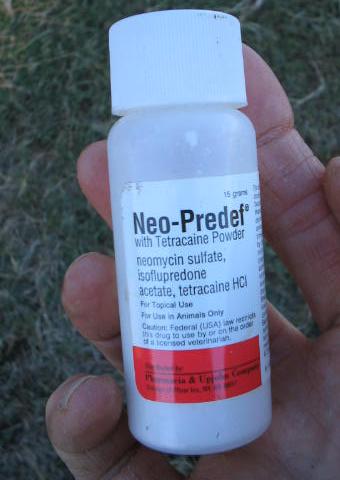 and the profile of the wound today is much lower than it was on Day 30: 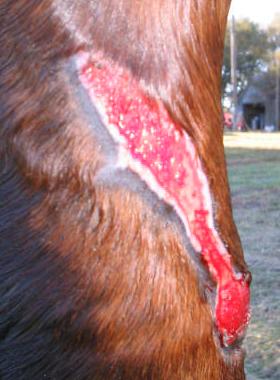 The last two times I've treated the wound, I have hosed and used Neopredef powder which "poofs" from a tiny hole in the top of the container when it is squeezed. I have covered with Fura-Zone as I was told it helps keep the wound moist, but it is tough to spread the Fura-Zone on the wound without disturbing the Neopredef powder . . . and the artical on wound care mentions that ointments can accelerate the growth of proud flesh . . . so I am tempted to just hose and use the Neopredef without the Fura-Zone. Wound coated with Neopredef (which absorbed the moisture of the wound and turned translucent.) 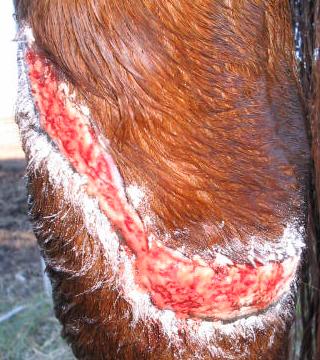
|
| Member: scooter |
Posted on Wednesday, Oct 24, 2007 - 6:38 am: Holly it looks Really good. It looks half the size it was in the beginning and it appears you are winning the proud flesh battle so far.Are you still wrapping or leaving it open? |
| Moderator: DrO |
Posted on Wednesday, Oct 24, 2007 - 11:03 am: Holly we do not recommend the use of steroid containing treatments because, though it may slow down the formation of granulation tissue, it also slows down the rate of reepithealization (new skin growth) believed to be mediated by suppressing insulin-like growth factor-I (IGF-I) in the wound. Note that many oral and inhaled steroid products carry the warning of delayed wound healing.DrO |
| Member: hwood |
Posted on Wednesday, Oct 24, 2007 - 2:22 pm: I did ask about the Neopredef earlier in this thread and tried to find it listed in the medications reference. I like what it has done to the wound. I think I will continue to use it intermittently, only if it looks like the granulation tissue is getting high again. I have not used it daily as was per my friend's instructions because it hasn't seemed necessary.In a recent issue of EQUUS, I read an article on treating proud flesh when Dixie first injured herself. Reading about proud flesh and seeing it are two different things, and I have tried to follow your instructions and use common sense and follow my gut as I've watched the wound change. From the EQUUS article, I will quote Dr. Ron Friedman an equine practitioner from Lake Oswego, Oregon: "The basic tenet is to minimize the size of the proud flesh so that granulation tissue can do its job without becoming exuberant and hindering the repair process . . . I've had the most success with topical steroids followed by excision to the level of adjoining normal epithelium. Sometimes repeat treatments are needed." Also from the article: Dr. Julie Cary, an equine surgeon at the University of Washington "has found that applying topical corticosteroids for a few days after debridement decreases the recuerrence of proud flesh." Sept. 2006, Issue 348, p 62. I am thinking that keeping the proud flesh at bay is the most important, and on Day 30, the granulation bed was getting bubbly and smooth and was above the level of the surrounding skin enough to get me worried . . . and I was afraid to let it continue, so used the Neopredef twice in the last 5 days. The proud flesh shrunk down considerably, so for me, it seemed to be the right thing to do. I will not apply any more Neopredef unless I see proud flesh getting "happy" again. Dixie's wound hasn't been wrapped for quite a while, Diane. She is turned out in a small pasture during the day where she can move freely, roll, and get plenty of sunshine. I have not allowed her to stay out when it rains, though. |
| Moderator: DrO |
Posted on Wednesday, Oct 24, 2007 - 5:45 pm: And that it slows down the healing does not concern you Holly?DrO Vitam Horm. 2000;59:217-39. Glucocorticoid-regulated gene expression during cutaneous wound repair. Beer HD, Fässler R, Werner S. Institute of Cell Biology, ETH-Hönggerberg, Zürich, Switzerland. Glucocorticoids exert a deleterious effect on the wound healing process, which has been suggested to result from the anti-inflammatory action of these steroids. In addition, recent studies have demonstrated that glucocorticoids regulate the expression of various genes at the wound site which are likely to encode key players in the wound repair process. Using a murine full-thickness excisional wound healing model, we analyzed the effect of dexamethasone on the expression of various cytokines, growth factors, enzymes, and extracellular matrix molecules in normal and wounded skin. We demonstrate that the proinflammatory cytokines interleukin-1 alpha and -beta, tumor necrosis factor alpha, keratinocyte growth factor, transforming growth factors beta 1, beta 2, and beta 3 and their receptors, platelet-derived growth factors and their receptors, tenascin-C, stromelysin-2, macrophage metalloelastase, and enzymes involved in the generation of nitric oxide are targets of glucocorticoid action in wounded skin. These results indicate that anti-inflammatory steroids inhibit wound repair at least in part by influencing the expression of these key regulatory molecules. |
| Member: hwood |
Posted on Wednesday, Oct 24, 2007 - 6:38 pm: Dr. O.,Of course it concerns me, but the above research wasn't told to me when I first asked about the powder, and I have to ask, "To what degree does the powder slow down the healing?" Aspartame can cause cancer, too, but in what amounts? Doesn't the growth of proud flesh also slow down the healing? Doesn't nitrofurazone encourage the growth of proud flesh, and wasn't I encouraged to continue to use it to keep the wound moist? One of the reasons I have seemed so intense about the care of this wound is that I have tried to do it RIGHT, but there is no right way if you listen to all the different vets and research. When I got confused above, you said that the wound was going to heal no matter what, and since my vet wants to use the copper sulfate and not excise any proud flesh, and since some vets say that this Neopredef works to keep proud flesh at bay, yet doesn't destroy the other good cells as the copper sulfate may, and since folks have used copper sulfate, excision, neopredef, Blu-Kote, Scarlet Oil, Fura-zone, Fur-all, Dermaclens, etc., and the wounds all seem to heal, I am trying to take the best course I can . . . and since every wound is different and every horse heals differently . . . I am only trying to find which way seems to be working for Dixie . . . and I will probably never do the same things with another wound as I have with this wound, but I'm trying, really I am . . . and this is just another example of why I'm so confused about "am I doing this right or should I be doing something different?" If there is a blueprint to use for healing a wound, I would like to have it, and I think that is what I have been asking for since the beginning of this thread, but seemed to find that there is no one way . . . so I have tried to improvise and experiment and take photos and ask questions, yet I'm the one who is here and can see the wound in a way that the photos don't show . . . and I have pretty much figured out that even if I botch this by using a corticosteroid that some vets recommend, that the wound is going to heal . . . and it really is looking good right now, honest . . . and maybe later, the research will show something different. Dr. O., your help and feedback is much appreciated, and if it weren't I wouldn't have continued to be a member for all of these years. This particular wound experience has been very frustrating for me, because it seems that there are many different treatments and courses to take that all finally lead to or fail to prevent the healing of a very nasty wound. |
| Moderator: DrO |
Posted on Thursday, Oct 25, 2007 - 8:26 am: Holly a blue print for healing wounds like this and even much worse wounds is in the article on long term wound care. It is exactly what I do when I treat a large wound and I get excellent results doing it. If I recommended any of this other stuff you have used, it would have been in the article too. And while I am glad to comment on things not in the article, considering the way you phrased the question on the Neopredf powder I thought my silence spoke volumes.DrO |
| Member: hwood |
Posted on Thursday, Oct 25, 2007 - 9:00 am: Okay.For me, the blueprint was too blurry. I was needing day by day instructions, thus the photos. When my vet cancelled the excision option, I was rattled. Compare it to running out of 4x4s in building a house and having to substitute 2x4s. I have done the best I can do not having that option. I am breathing easier now as I can see my choices working and the healing looking good. |
is The Horseman's Advisor
Helping Thousands of Equestrians, Farriers, and Veterinarians Every Day
All rights reserved, © 1997 -
